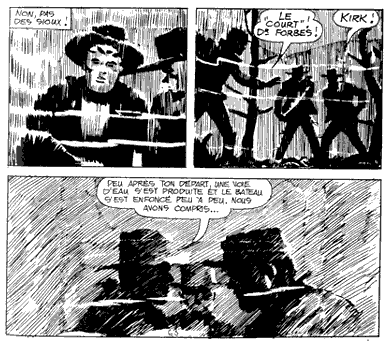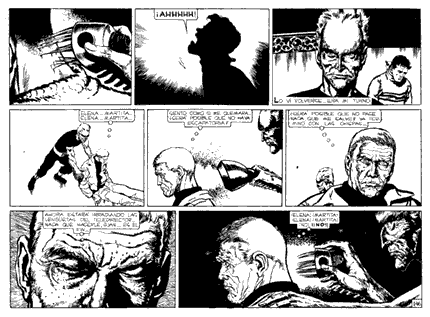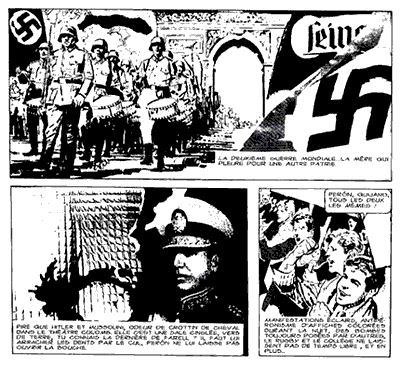Artwork by Hugo Pratt.
Hector German Oesterheld is probably the most important comic writer from South America. With his large oeuvre, full of realism and poetry, Oesterheld became a martyr of Argentinian comics. He worked with the best Argentinian artists in the field, such as Alberto Breccia, Francisco Solano Lopez, Horacio Altuna, Hugo Pratt and Walter Fahrer. With a geology degree in his pocket, he began his writing career in the early 1940s. His first work appeared in the daily La Prensa and at the publishing house Codex. He then moved over to Abril publishers, where he began his extensive career as a comic writer.
In the early stages of his career, Oesterheld wrote such stories as 'Alan y Crazy' (art Eugenio Zoppi), 'Ray Kitt' (art Hugo Pratt) and 'Bull Rocket' (art Paul Campani, Francisco Solano Lopez, Julio Schiaffino and others). In 1952 he created the famous western epic 'El Sargento Kirk' ('Sgt Kirk') with Hugo Pratt in Misterix magazine. This series already showed Oesterheld's unconventional way of writing. The series starts of with Sergeant Kirk deserting after assisting on a massacre of Indians by the American Army. Kirk then devotes himself to defending the Indians. Other creations of the 1950s are 'Tarpón' (art Daniel Haupt), 'Uma-Uma' (art Solano Lopez), 'Indio Suarez' (art Carlos Freixas and later Carlos Cruz). Other artists he wrote for at this time, were Ivo Pavone ('El Zarpa', 'Burt Zane'), Enrique Cristobal ('Dragón Blanco'), Luis Dominguez ('Scout River'), Carlos Roume and Walter Casadei ('Star Kenton').
Artwork by Francisco Solano Lopez.
In 1957, Oesterheld and his brother Jorge launched their own publishing company, Ediciones Frontera. This publishing house published magazines such as Hora Cera Mensual and Frontera Mensuel, for which Oesterheld wrote an innumerous amount of comics. Notable are the unusual science fiction stories he wrote, such as 'El Eternauta'. In this series, Oesterheld describes his own meeting with a time traveler of eternity, who had already lived over 100 lives. Illustrated by Francisco Solano Lopez, this series started in 1958 in the weekly magazine, Hora Cero Semanal. Other important stories for these magazines were the war series he wrote for Hugo Pratt ('Ticonderoga' and 'Ernie Pike'), the more conventional western 'Randall' (with Arturo Del Castillo) and the piracy comic 'Capitan Caribe' (with Dino Battaglia).
Artwork by Alberto and Enrique Breccia.
In the 1960s, Argentina fell prey to a major economic crisis. Oesterheld was forced to close Frontera's doors. However, he continued writing for several small publishers and the Chilean Zig-Zag publishers. On 17 August 1962, Oesterheld launched the 'Mort Cinder' series, illustrated by Alberto Breccia, considered by many to be their masterpiece. In the following years, Oesterheld wrote such stories as 'Artemio, El Taxista de Buenos Aires' (art Nestor Olivera and Pablo Zahlut), 'Russ Congo' (art José Clemen) and 'Guerra de los Antartes' (art León Napoo and later Gustavo Trigo). His most notable work of that time was the biography of Che Guevara ('Che') he created in 1968 for the Chilean market (art Alberto and Enrique Breccia).
According to some sources, this work became fatal for Oesterheld. However, it is also believed that Oesterheld and his daughters were members of the leftist guerrilla group, the Montoneros. When the military took power in Argentina in the mid-1970s, Oesterheld was arrested and taken from his home with his four daughters. Nothing was heard of him ever since. When the Italian journalist Alberto Ongaro did inquiries about his disappearance in 1979, he got the eerie reply: "We did away with him because he wrote the most beautiful story of Ché Guevara ever done".
Hector German Oesterheld was an influence on Liniers.
'Mort Cinder' script, by Hector Oesterheld.





